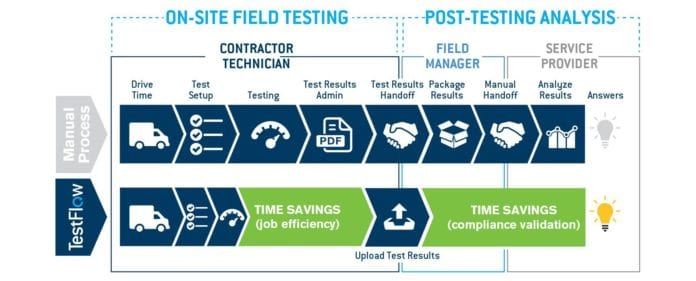Telecommunications carriers depend on optical fiber networks with ever-faster speeds and greater capacity to serve the insatiable data demands of their customers. Whether for fiber-to-the-antenna, Distributed Antenna Systems or fiber-to-the-home for residential or enterprise customers, those larger, faster fiber connections are a key competitive advantage for operators.
Such fiber installations need to be both rapid and high-quality, so that customers don’t go elsewhere while waiting for fiber to arrive or have a poor user experience when it does.
However, due to scale and complexity, fiber deployments are often difficult to manage for quality assurance. The traditional field testing process is highly manual and demands repetitive data entry in the field under challenging conditions. On average, technicians spend 50% of their time on data entry and keeping track of test-point identification and reporting. Even with so much time spent recording data, a significant amount of field test results contain data-entry errors. As techs try to reconcile standard operating procedures with real-world field conditions, results may not get saved; tests might be performed with the wrong thresholds, or required tests not conducted; results files get misnamed or associated with the wrong location, or test-points (e.g. fiber or bulkhead connectors) get misidentified. Due to the reams of test-result data provided in the closeout process, most testing is only spot-checked – so many errors aren’t uncovered until fiber customers start having problems.
New field testing solutions, such as EXFO’s TestFlow, reduce the data-entry burden on techs through automated test sequences and integrated results tracking and analysis: better-quality data that is easier and faster for techs to produce. At a high level, TestFlow accomplishes this as follows:
- Managers create and provide intelligent, digitized job definitions and test configuration files to techs’ test units. A centralized server stores test-results files and an associated metrics database.
- With a single, intuitive user interface, the all-in-one test-unit application provides the ability to run the automated job-specific sequences, ensuring that all necessary tests are conducted in line with proper procedures while saving techs’ valuable time (and eliminating errors) with predefined test-point IDs and test-results filenames. Test results are automatically uploaded to the centralized server for immediate results-to-metrics processing.
- A web-based user interface serves up metrics from the field through the centralized database, so that project managers and supervisors can track and assess on-going work, comply with network standards and maximize technician efficiency.
In addition to those features for improved field test speed and compliance, TestFlow offers rich analytics for the identification of trends large and small. Data dashboards provide the ability to both drill down into detailed reports and even individual test results, or to identify larger trends through data that can be aggregated by classifications such as by region, by contractor or by equipment vendor and model.
The new efficiencies, improved test data accuracy and new insights provided by TestFlow enable swift, superior fiber installation. Learn more about TestFlow here.

